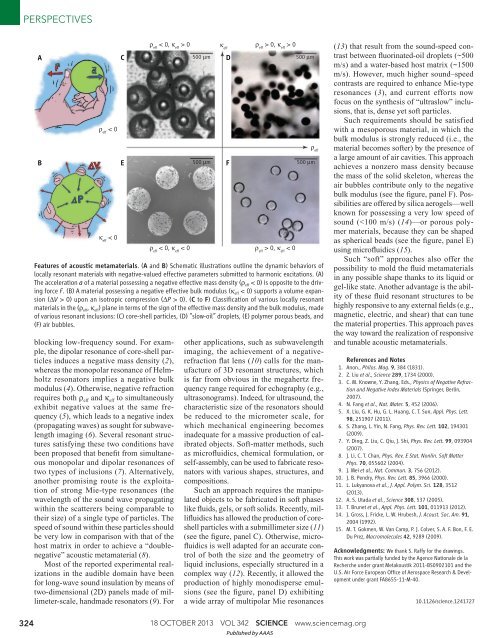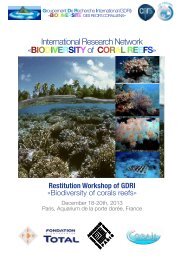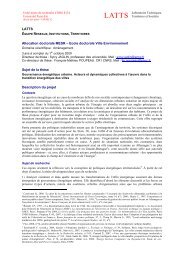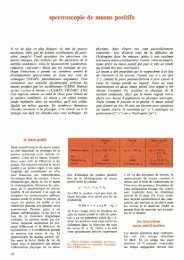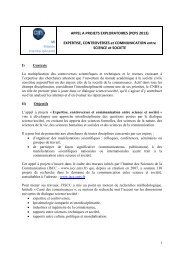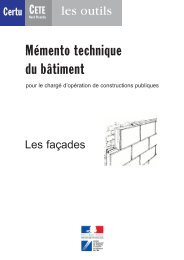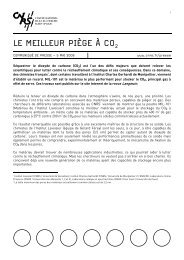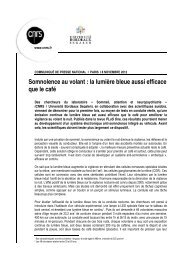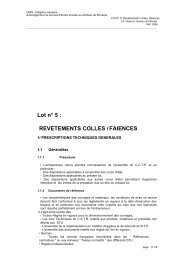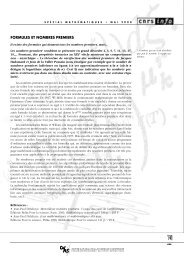Soft Acoustic Metamaterials - CNRS
Soft Acoustic Metamaterials - CNRS
Soft Acoustic Metamaterials - CNRS
You also want an ePaper? Increase the reach of your titles
YUMPU automatically turns print PDFs into web optimized ePapers that Google loves.
PERSPECTIVES<br />
A<br />
B<br />
ρ eff<br />
< 0<br />
κ eff<br />
< 0<br />
blocking low-frequency sound. For example,<br />
the dipolar resonance of core-shell particles<br />
induces a negative mass density ( 2),<br />
whereas the monopolar resonance of Helmholtz<br />
resonators implies a negative bulk<br />
modulus ( 4). Otherwise, negative refraction<br />
requires both ρ eff and κ eff to simultaneously<br />
exhibit negative values at the same frequency<br />
( 5), which leads to a negative index<br />
(propagating waves) as sought for subwavelength<br />
imaging ( 6). Several resonant structures<br />
satisfying these two conditions have<br />
been proposed that benefit from simultaneous<br />
monopolar and dipolar resonances of<br />
two types of inclusions ( 7). Alternatively,<br />
another promising route is the exploitation<br />
of strong Mie-type resonances (the<br />
wavelength of the sound wave propagating<br />
within the scatterers being comparable to<br />
their size) of a single type of particles. The<br />
speed of sound within these particles should<br />
be very low in comparison with that of the<br />
host matrix in order to achieve a “doublenegative”<br />
acoustic metamaterial ( 8).<br />
Most of the reported experimental realizations<br />
in the audible domain have been<br />
for long-wave sound insulation by means of<br />
two-dimensional (2D) panels made of millimeter-scale,<br />
handmade resonators ( 9). For<br />
C<br />
E<br />
ρ eff<br />
< 0, κ eff<br />
> 0<br />
500 µm D<br />
500 µm<br />
500 µm<br />
ρ eff<br />
> 0, κ eff<br />
> 0<br />
ρ eff<br />
< 0, κ eff<br />
< 0 ρ eff<br />
> 0, κ eff<br />
< 0<br />
500 µm<br />
Features of acoustic metamaterials. (A and B) Schematic illustrations outline the dynamic behaviors of<br />
locally resonant materials with negative-valued effective parameters submitted to harmonic excitations. (A)<br />
The acceleration a of a material possessing a negative effective mass density (ρ eff < 0) is opposite to the driving<br />
force F. (B) A material possessing a negative effective bulk modulus (κ eff < 0) supports a volume expansion<br />
(∆V > 0) upon an isotropic compression (∆P > 0). (C to F) Classifi cation of various locally resonant<br />
materials in the (ρ eff , κ eff ) plane in terms of the sign of the effective mass density and the bulk modulus, made<br />
of various resonant inclusions: (C) core-shell particles, (D) “slow-oil” droplets, (E) polymer porous beads, and<br />
(F) air bubbles.<br />
κ eff<br />
F<br />
ρ eff<br />
other applications, such as subwavelength<br />
imaging, the achievement of a negativerefraction<br />
flat lens ( 10) calls for the manufacture<br />
of 3D resonant structures, which<br />
is far from obvious in the megahertz frequency<br />
range required for echography (e.g.,<br />
ultrasonograms). Indeed, for ultrasound, the<br />
characteristic size of the resonators should<br />
be reduced to the micrometer scale, for<br />
which mechanical engineering becomes<br />
inadequate for a massive production of calibrated<br />
objects. <strong>Soft</strong>-matter methods, such<br />
as microfluidics, chemical formulation, or<br />
self-assembly, can be used to fabricate resonators<br />
with various shapes, structures, and<br />
compositions.<br />
Such an approach requires the manipulated<br />
objects to be fabricated in soft phases<br />
like fluids, gels, or soft solids. Recently, millifluidics<br />
has allowed the production of coreshell<br />
particles with a submillimeter size ( 11)<br />
(see the figure, panel C). Otherwise, microfluidics<br />
is well adapted for an accurate control<br />
of both the size and the geometry of<br />
liquid inclusions, especially structured in a<br />
complex way ( 12). Recently, it allowed the<br />
production of highly monodisperse emulsions<br />
(see the figure, panel D) exhibiting<br />
a wide array of multipolar Mie resonances<br />
( 13) that result from the sound-speed contrast<br />
between fluorinated-oil droplets (~500<br />
m/s) and a water-based host matrix (~1500<br />
m/s). However, much higher sound–speed<br />
contrasts are required to enhance Mie-type<br />
resonances ( 3), and current efforts now<br />
focus on the synthesis of “ultraslow” inclusions,<br />
that is, dense yet soft particles.<br />
Such requirements should be satisfied<br />
with a mesoporous material, in which the<br />
bulk modulus is strongly reduced (i.e., the<br />
material becomes softer) by the presence of<br />
a large amount of air cavities. This approach<br />
achieves a nonzero mass density because<br />
the mass of the solid skeleton, whereas the<br />
air bubbles contribute only to the negative<br />
bulk modulus (see the figure, panel F). Possibilities<br />
are offered by silica aerogels—well<br />
known for possessing a very low speed of<br />
sound (


